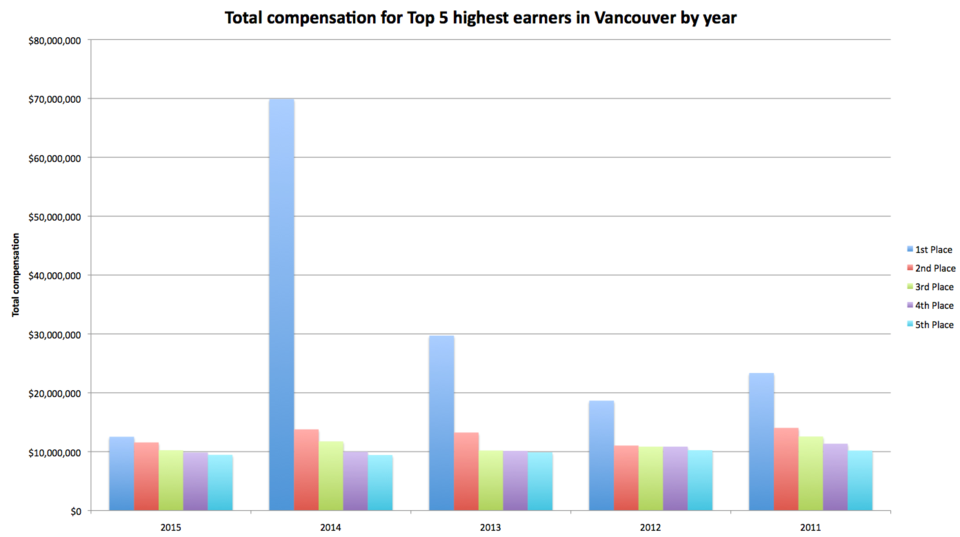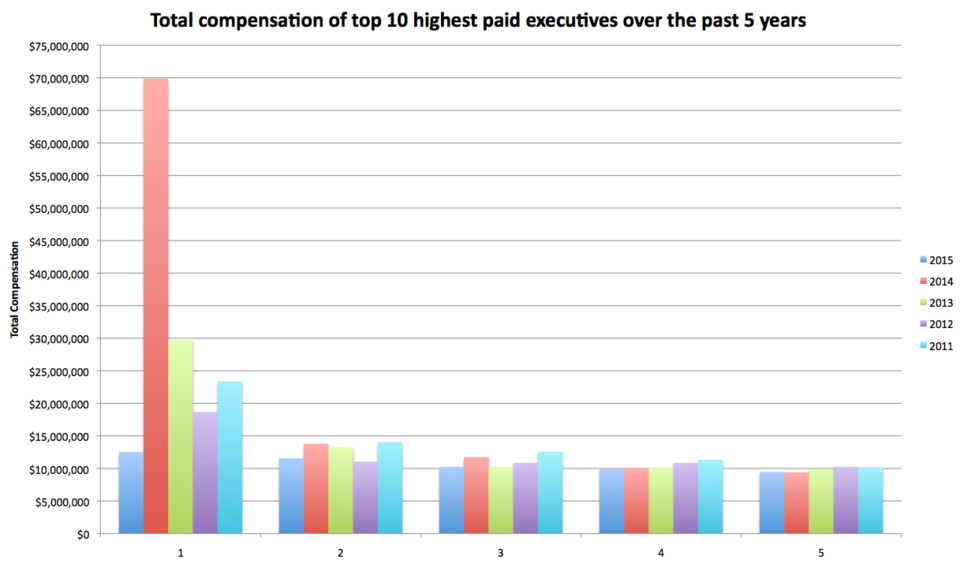Down on the shop floor, salaries for executives on Business in Vancouver’s 2016 Top 100 highest-paid executives list might appear excessive.
After all, the highest paid executive, Telus Corp. (TSX:T) CEO Darren Entwistle’s $12,532,296 in 2015 compensation is 163 times that of the $76,770 median household income in B.C. in 2014, the most recent year for which Statistics Canada has data.
Overseeing B.C.’s largest public company, however, is a complex task, and compensation consultants say that job complexity is the biggest determinant of a top executive’s pay.
“People ask whether pay is higher whenever a company is larger, but it is not that simple,” said Logan HR partner Vince Chow, who specializes in determining compensation rates for clients. “Large organizations just tend to be more complex, and they need leaders who can handle that complexity.”
Telus’ services range from home Internet, TV and land-line phones to electronic medical records, mobile phones and related services. The company also has a range of services for businesses, including debit and credit card readers.
Little wonder then that Telus has more executives (six) on BIV’s Top 100 list than any other company.
Many companies have five executives on the list, including three that are among B.C.’s 10 largest public companies (ranked by revenue): Teck Resources Ltd. (TSX:TCK.B) (No. 2), Goldcorp Inc. (TSX:G) (No.4) and Lions Gate Entertainment Corp. (NYSE:LGF) (No. 10).
Lululemon Athletica Inc. (Nasdaq:LULU) (No. 11) and Eldorado Gold Corp. (TSX:ELD) (No. 20) are two other companies among B.C.’s 20 largest companies that also have five executives on B.C.’s top-paid executives’ list.
Not all of the largest companies have executives on the list, and some sectors, including forestry and wood products, are under-represented, compared with sectors such as mining or technology.

B.C.’s sixth-largest company, lumber producer Canfor Corp. (TSX:CFP), is the largest without executive representation on BIV’s Top 100 highest-paid list.

Its CEO, Don Kayne, was paid $1,111,293 in 2015. That’s far below the $1,721,440 that Pan American Silver Corp. (TSX:PAA) CEO Michael Steinmann received as B.C.’s 100th top-paid executive.

Had there been a shift in control, where a new group obtained a majority of Canfor’s board of directors or a 20% stake in the company, and Kayne was let go, he would have been entitled to $2,690,000 in severance – more than double his 2015 compensation total.
Change-of-control agreements are common, Chow said.
What differs in these agreements are the specifics that outline how big a compensatory bump executives are entitled to when they’re let go after a shift in control.
(Image: Vince Chow is a partner at Logan HR | Orange 21 Photography)
Other forestry and wood products companies with scant representation on BIV’s list of top paid executives include West Fraser (TSX:WFT), which is B.C.’s fifth-largest company by revenue yet had only one executive on the list: CEO Ted Seraphim, whose $2,469,030 in compensation was enough to rank No. 60.
Catalyst Paper (TSX:CYT) is B.C.’s 15th-largest public company, but it had no executives on the top paid list. Neither did Interfor Corp. (TSX:IFP), B.C.’s 16th-largest company, or Taiga Building Products Ltd. (TSX:TBL), B.C.’s 18th-largest company ranked by revenue.
On the other hand, there were companies that generated no revenue in 2015 but have multiple executives on BIV’s top-paid executives list.
Pretium Resources Inc. (TSX:PVG) has four executives on the list despite generating steady losses and no revenue; NovaGold Resources Inc. (TSX:NG), which lost almost $32 million last year while generating no revenue, has two executives on the list.
Chow would not comment on specific companies but said there are sectors, such as biotech or mining, where companies are exploring for revenue-generating products and it is not uncommon for them to rack up debt as they operate.
“Board members at those companies may determine that they still want the executive pay to be compared to a certain peer group that has revenue,” Chow said.
“It’s a question for them to decide. They say that their philosophy is to hire a higher calibre of executive from top large, complex organizations or they could hire from mid-size organizations or small organizations.” •




